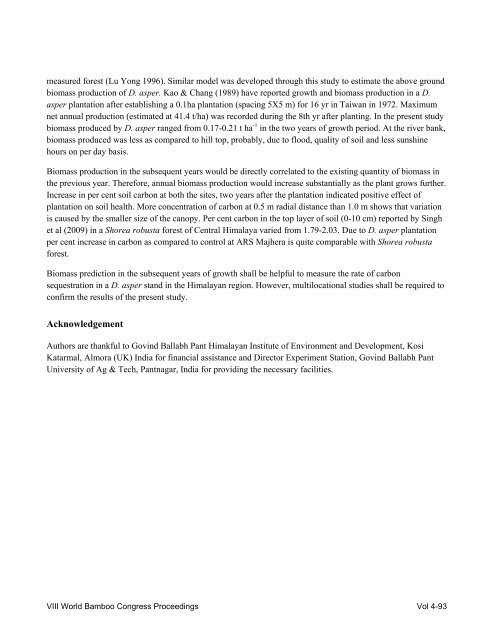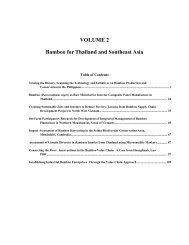WBC-VIII-Vol.4 – Resources – Forestry, Plantations and ... - BambuSC
WBC-VIII-Vol.4 – Resources – Forestry, Plantations and ... - BambuSC
WBC-VIII-Vol.4 – Resources – Forestry, Plantations and ... - BambuSC
Create successful ePaper yourself
Turn your PDF publications into a flip-book with our unique Google optimized e-Paper software.
measured forest (Lu Yong 1996). Similar model was developed through this study to estimate the above ground<br />
biomass production of D. asper. Kao & Chang (1989) have reported growth <strong>and</strong> biomass production in a D.<br />
asper plantation after establishing a 0.1ha plantation (spacing 5X5 m) for 16 yr in Taiwan in 1972. Maximum<br />
net annual production (estimated at 41.4 t/ha) was recorded during the 8th yr after planting. In the present study<br />
biomass produced by D. asper ranged from 0.17-0.21 t ha -1 in the two years of growth period. At the river bank,<br />
biomass produced was less as compared to hill top, probably, due to flood, quality of soil <strong>and</strong> less sunshine<br />
hours on per day basis.<br />
Biomass production in the subsequent years would be directly correlated to the existing quantity of biomass in<br />
the previous year. Therefore, annual biomass production would increase substantially as the plant grows further.<br />
Increase in per cent soil carbon at both the sites, two years after the plantation indicated positive effect of<br />
plantation on soil health. More concentration of carbon at 0.5 m radial distance than 1.0 m shows that variation<br />
is caused by the smaller size of the canopy. Per cent carbon in the top layer of soil (0-10 cm) reported by Singh<br />
et al (2009) in a Shorea robusta forest of Central Himalaya varied from 1.79-2.03. Due to D. asper plantation<br />
per cent increase in carbon as compared to control at ARS Majhera is quite comparable with Shorea robusta<br />
forest.<br />
Biomass prediction in the subsequent years of growth shall be helpful to measure the rate of carbon<br />
sequestration in a D. asper st<strong>and</strong> in the Himalayan region. However, multilocational studies shall be required to<br />
confirm the results of the present study.<br />
Acknowledgement<br />
Authors are thankful to Govind Ballabh Pant Himalayan Institute of Environment <strong>and</strong> Development, Kosi<br />
Katarmal, Almora (UK) India for financial assistance <strong>and</strong> Director Experiment Station, Govind Ballabh Pant<br />
University of Ag & Tech, Pantnagar, India for providing the necessary facilities.<br />
<strong>VIII</strong> World Bamboo Congress Proceedings Vol 4-93




